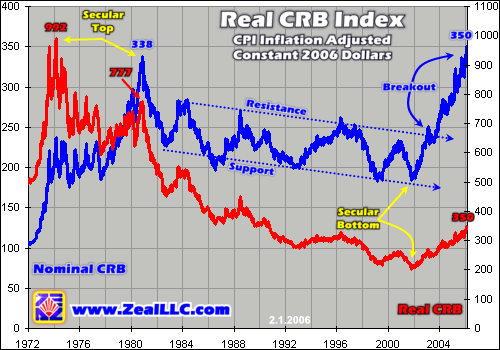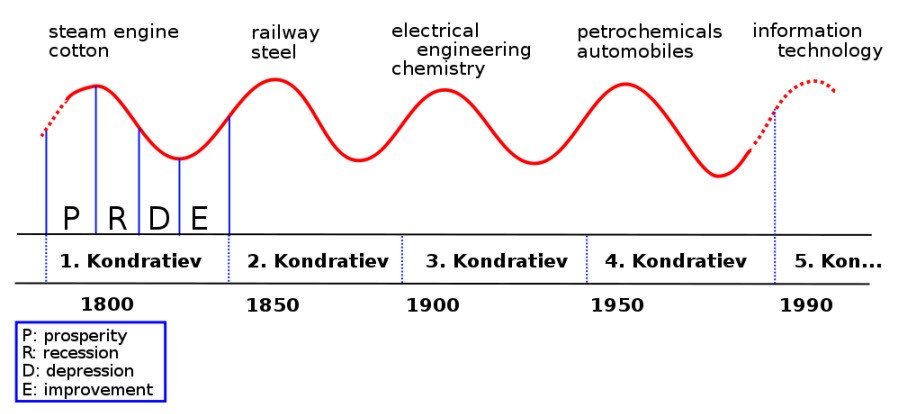21St Century Commodities Bull
Post on: 24 Июль, 2015 No Comment

21st Century Commodities Bull
Scott Wright February 3, 2006 3200 Words
The turn of the century has brought upon a change of guard for the financial markets. The general stock markets peaked and a new secular commodities bull was born. Even though many have had to endure the pain of a bursting stock-market bubble, the global economy has been thriving since the turn of the millennium and I suspect those in the future will look back on the 21st century and tag it as the Consumption Age.
Globally this consumption is not necessarily that of excess or overindulgence. Rather it may be considered more or less a movement of economic progressivism. Lending part to this trend is the fact that our global population is growing at a blistering pace and will continue to do so for years to come. Many people overlooked the incredible milestone that was attained in 1999. Our enduring planet lofted above the six billion mark in total population.
To put this growing and changing world into perspective, it was only about 200 years ago that the global population passed the one billion mark. According to the U.S. Census Bureau it only took another 118 years for the global population to double, reaching two billion in 1922. It then took 37 years to reach three billion, 15 years to reach four billion, 13 years to reach five billion and only 12 years to reach six billion.
Today we are already past the half-way mark to the next billion. Now with 6.5 billion potential consumers living in an era in which considerable industrial and technological advances are demanding more resources than ever, it’s no wonder global demand for commodities has soared. In this high-tech world we live in, commodities are zealously sought after in order to maintain, support and develop this growing population. Because of this, commodities of all types are soaring in value as their availability and economics are continually being challenged. Simply put, supply has not been able to keep up with demand.
This massively increasing population has contributed to an increase in consumption in virtually all goods and services, and in turn has contributed to the robust economies we are seeing today that are seemingly necessary in order to maintain status quo. Almost not surprising, GDP in the U.S. has increased ten-fold since 1972, China has seen a ten-fold since 1978 and the U.K. has seen its ten-fold since 1976. The macroeconomics we see here tell an incredible story in which commodities have and will play a large part now and in the future.
It is important for everyone to understand why we are in the midst of a commodities craze from a socioeconomic perspective, if for no other reason than to understand how it may affect their everyday lives. It is especially important to understand this if you are an investor. Investors and speculators who have taken part in the commodities bull thus far have scored incredible gains if they have played the upside of this secular trend.
It’s not too late though to continue to profit from this commodities bull. We are still likely in the first half of a long-term bull market. To this day commodities of all sorts are still in the midst of major economic imbalances. Global demand for both soft and hard commodities is on the rise and supply is struggling to keep up. It is the prudent investor or speculator who is able to recognize this pattern before it corrects itself and is able to leverage his capital to take advantage of the upside.
Our task now is to determine which commodities to focus on from an investment perspective. Now depending on whom you ask and where you look, the definitions for soft and hard commodities tend to range across the board. For our purposes we will consider any commodity that can be grown or raised a soft commodity, and any commodity that you have to mine or drill for a hard commodity.
Soft commodities tend to have a renewing characteristic. Crops can be re-grown, and typically in the same spot as the previous crop. And meat commodities are the result of animal breeding that has remarkably accurate forecasting. Softs are integral in this bull market, but are not the major player.

Commodities such as coffee, cotton, cocoa, orange juice and hogs are examples of soft commodities and are all non-finite in nature. As long as a global ice age doesn’t miraculously strike the earth, crops will always be grown. And I surely doubt that cows, pigs and chickens will ever become extinct.
Now there are external factors that can influence the pricing of these soft commodities and they are certainly not exempt from supply and demand pressures. Weather, disease, geopolitical unrest and labor are examples of some of these factors. But when an economic imbalance presents itself, the fact that these commodities are renewable typically avoids a pushing of the panic button.
Even so, soft commodities continue to play a large role in the overall futures markets and are not exempt from the volatility most people associate with commodities. Farmers need to lock in prices and speculators play the game to try and capture profits.
In come hard commodities. Hards consist mainly of energy and metals and require extensive capital expenditures in order to retrieve these commodities from the earth. These commodities are finite in nature and have limited resources. Hards have been on a tear the last four years, have captured mainstream media attention and are the major player in this secular commodities bull market.
Precious metals, crude oil and natural gas are not the only commodities that have taken part in this bull. These commodities do command the lion’s share of attention but let’s not overlook those others that play an integral part in the global economy. Below are many of the popular hard commodities and their bull-to-date highs since the beginning of 2001.














